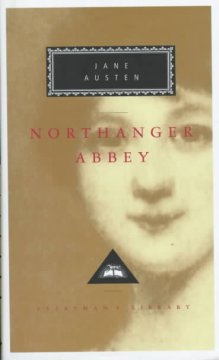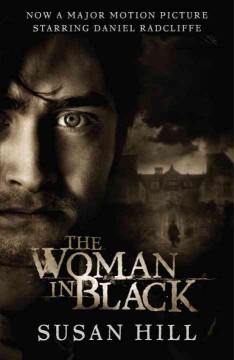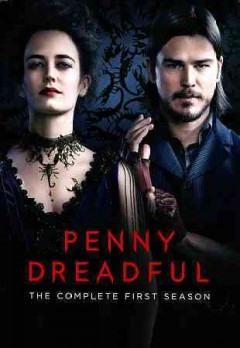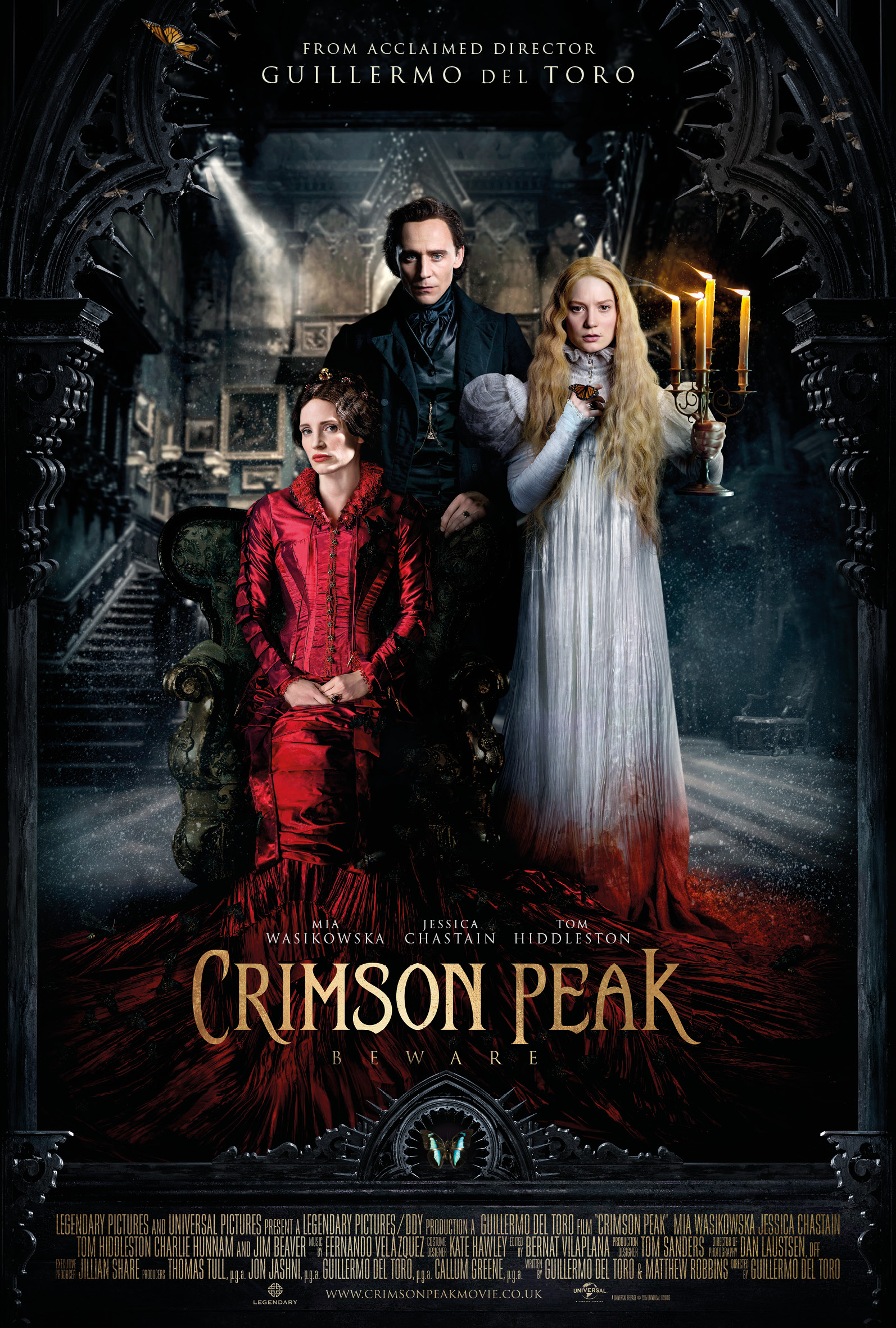This is a very tricky post to write without getting mired in a vast quagmire of spoilery-spoilers, but we’re going to give it our best shot.
Crimson Peak has been touted as several things, all at once: a horror movie, a gothic romance, and, perhaps, most interestingly, as a feminist revisionary tale. While the jury still seems to be out on whether it has succeeded in any of these categories, what everyone seems to agree on is that fact that this is probably one of the most unabashedly lush, visually detailed, and simply beautiful films you will see in quite some time. Guillermo Del Toro doesn’t just use all the crayons in the box…he melts them down and creates new ones, because there simply aren’t enough colors (or textures, or nuances) in our everyday world for him, and the results are sometimes overwhelming, sometimes a little garish, but they are always extraordinary in their own way.
 While an ideal Halloween film in its own right, Crimson Peak offers plenty of literary perks. It pays reverent homage to the gothic romances–those marvelous blend of love and death, and the clash of the fantastic with the mundane. No where is this more evident then when Tom Hiddleston (as Sir Thomas Sharpe) arrives with his new bride, Edith (Mia Wasikowska) at his family estate. The front lawn of the manor is covered with these weirdly grotesque, spider-like cranes, which we are told are the height of technological achievement, that will dig clay from the depths of the earth. The manor itself, however, is a ghastly, crumbling wreck without a roof. While it makes for stunningly beautiful shots, it’s snowing inside the house. I’m not sure even Tom Hiddleston could convince me to hang out in a hatless house.
While an ideal Halloween film in its own right, Crimson Peak offers plenty of literary perks. It pays reverent homage to the gothic romances–those marvelous blend of love and death, and the clash of the fantastic with the mundane. No where is this more evident then when Tom Hiddleston (as Sir Thomas Sharpe) arrives with his new bride, Edith (Mia Wasikowska) at his family estate. The front lawn of the manor is covered with these weirdly grotesque, spider-like cranes, which we are told are the height of technological achievement, that will dig clay from the depths of the earth. The manor itself, however, is a ghastly, crumbling wreck without a roof. While it makes for stunningly beautiful shots, it’s snowing inside the house. I’m not sure even Tom Hiddleston could convince me to hang out in a hatless house.

What’s interesting here is that it is the people in the house, and not the house itself, that makes this story what it is. This is no “Fall of the House of Usher”, where the characters are trapped within the walls of a crumbling house. Instead, they make the house into the inhospitable nightmare that it becomes.
In addition, Crimson Peak also affirms what The Guardian claimed over the weekend: The Ghost Story is back…with a vengeance. Some point to the rise of genre fiction and the general acceptance of ghost stories as legitimate, but there is a lot more behind the ghost story to simply wanted to enjoy having our pants scared off. They also offer us a safe place to deal with some of our greatest concerns–about death, about the possibility of an afterlife, about the weight of regrets, and the hope of righting irredeemable wrongs.
It’s also about scaring the pants off people, too, let’s be honest.
And so, since we have begun the countdown to All Hallows Read, and because Crimson Peak is a great deal of fun, regardless of whatever else it might be, here are some suggestions for some other gothic/ghost stories for your reading pleasure:
 Northanger Abbey: The first of Jane Austen’s novels to be completed for publication was not published until after her death in 1817. The book is a send-up of the standard novel, which was wildly popular in the opening years of the nineteenth century. Rather than having a ravishingly beautiful heroine who is too good and pure to consider her hero’s affections until the final scene, Austen gives us Susan, who is a wonderfully down-to-earth, middle class young lady who loves the hero before he has actually even given her a second thought. Austen also explicitly shows all of Susan’s fears and premonitions of danger to be utterly unfounded (and often the result of quite commonplace occurrences). This is definitely one of Austen’s snarkier novels, and a terrific entrance into her work for those who haven’t had much experience with her–it’s also fun to see the way social criticism worked in the era before Buzzfeed.
Northanger Abbey: The first of Jane Austen’s novels to be completed for publication was not published until after her death in 1817. The book is a send-up of the standard novel, which was wildly popular in the opening years of the nineteenth century. Rather than having a ravishingly beautiful heroine who is too good and pure to consider her hero’s affections until the final scene, Austen gives us Susan, who is a wonderfully down-to-earth, middle class young lady who loves the hero before he has actually even given her a second thought. Austen also explicitly shows all of Susan’s fears and premonitions of danger to be utterly unfounded (and often the result of quite commonplace occurrences). This is definitely one of Austen’s snarkier novels, and a terrific entrance into her work for those who haven’t had much experience with her–it’s also fun to see the way social criticism worked in the era before Buzzfeed.
 The Woman in Black: You can’t wander too far into a study of the ghost story without bumping into Susan Hill’s classic. The fact that it has been a success in print, on stage and on screen gives some idea of the endurance and the power of this story: when Arthur Kipps, a young solicitor is sent to a solitary estate in the north of England to settle the estate of a reclusive elderly woman, he finds not only a house full of inexplicable noises, terrifying visions, and a rising sense of menace, he also finds himself touched by a deadly curse. Though the story is full of subtle illusions and creepy descriptions, the film is a smorgasbord of jump-scares and musical stings that are guaranteed to keep your heart pumping.
The Woman in Black: You can’t wander too far into a study of the ghost story without bumping into Susan Hill’s classic. The fact that it has been a success in print, on stage and on screen gives some idea of the endurance and the power of this story: when Arthur Kipps, a young solicitor is sent to a solitary estate in the north of England to settle the estate of a reclusive elderly woman, he finds not only a house full of inexplicable noises, terrifying visions, and a rising sense of menace, he also finds himself touched by a deadly curse. Though the story is full of subtle illusions and creepy descriptions, the film is a smorgasbord of jump-scares and musical stings that are guaranteed to keep your heart pumping.
 Little Sister Death: This new release was discovered posthumously in the papers of beloved southern writer William Gay. Apparently, Gay had a career-long interest in the Tennessee Bell Witch case (which was also the inspiration for The Blair Witch Project). In this telling, a young author brings his new wife and young daughter on his exploration of the myth of Virginia Beale, known as the Faery Queen of the Haunted Dell…but what he finds is a deep and tangled family history of blood and hatred that forces him to reconsider everything he believed–including his own sanity. This book also features a touching introduction to Gay himself that will convince new readers to explore the rest of his body of work as soon as possible.
Little Sister Death: This new release was discovered posthumously in the papers of beloved southern writer William Gay. Apparently, Gay had a career-long interest in the Tennessee Bell Witch case (which was also the inspiration for The Blair Witch Project). In this telling, a young author brings his new wife and young daughter on his exploration of the myth of Virginia Beale, known as the Faery Queen of the Haunted Dell…but what he finds is a deep and tangled family history of blood and hatred that forces him to reconsider everything he believed–including his own sanity. This book also features a touching introduction to Gay himself that will convince new readers to explore the rest of his body of work as soon as possible.
 Penny Dreadful: If you’re looking to capture the same aura of Crimson Peak, and revel in that late-Victorian clash of life and death, sex and propriety, honor and secrecy, you won’t have to look any further than this gruesomely delightful series. Penny Dreadful is a marvelous mash-up of gothic adventure and literary references, as Victor Frankenstein, Dorian Gray, and Count Dracula all rub shoulders with the relentless and bewitching Penny, who is driven by a quasi-spiritual, deeply personal need for revenge. Though certainly not as shocking or as difficult to watch as, say American Horror Story, this is still a series that pushes boundaries, but does so in a clever way that will leave you curious and eager for what dark marvels wait around the next corner….
Penny Dreadful: If you’re looking to capture the same aura of Crimson Peak, and revel in that late-Victorian clash of life and death, sex and propriety, honor and secrecy, you won’t have to look any further than this gruesomely delightful series. Penny Dreadful is a marvelous mash-up of gothic adventure and literary references, as Victor Frankenstein, Dorian Gray, and Count Dracula all rub shoulders with the relentless and bewitching Penny, who is driven by a quasi-spiritual, deeply personal need for revenge. Though certainly not as shocking or as difficult to watch as, say American Horror Story, this is still a series that pushes boundaries, but does so in a clever way that will leave you curious and eager for what dark marvels wait around the next corner….

